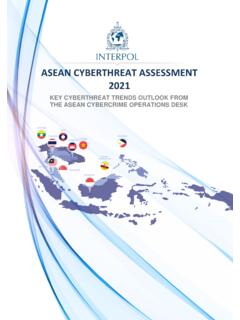Transcription of COVID-19 Cybercrime Analysis Report - INTERPOL
1 COVID-19 impact Cybercrime :AUGUST 20202 INTERPOL 2020 INTERPOL General Secretariat200, quai Charles de Gaulle69006 LyonFranceWeb: : COVID-19 IMPACT3 CONTENTSI ntroduction 4 Evolution of Cybercrime Trends and Threats amid COVID-19 6 Regional Cybercrime Trends 6 AFRICA 6 AMERICAS 6 ASIA AND SOUTH PACIFIC (ASP) 6 EUROPE 7 MIDDLE EAST AND NORTH AFRICA (MENA) 7 Key COVID-19 Cyberthreats 8 ONLINE FRAUD AND PHISHING 8 DISRUPTIVE MALWARE (RANSOMWARE AND DDOS)
2 9 MALICIOUS DOMAINS 10 DATA HARVESTING MALWARE 11 MISINFORMATION 12 INTERPOL Response 14 Priorities and Recommendations 16 Short-Term Projections 18 Conclusion 19 JULY 20204 INTRODUCTIONThe unprecedented coronavirus pandemic is profoundly affecting the global cyberthreat landscape. Compounding a global health crisis with a sharp increase in cybercriminal activities related to COVID-19 is putting significant strain on law enforcement communities worldwide. According to one of INTERPOL s private sector partners, 907,000 spam messages, 737 incidents related to malware and 48,000 malicious URLs all related to COVID-19 were detected between January and 24 April, 20201.
3 To maximise damage and financial gain, cybercriminals are shifting their targets from individuals and small businesses to major corporations, governments and critical infrastructure, which play a crucial role in responding to the outbreak. Concurrently, due to the sudden, and necessary, global shift to teleworking, organizations have had to rapidly deploy remote systems, networks and applications. As a result, criminals are taking advantage of the increased security vulnerabilities arising from remote working to steal data, generate profits and cause disruption. In light of these events, INTERPOL s Cybercrime Directorate produced this Global Assessment Report on COVID-19 related Cybercrime based on its unique access to data from 194 member countries and private partners to provide a comprehensive overview of the Cybercrime landscape amid the pandemic.
4 The Report is based on data collected from member countries and INTERPOL private partners as part of the INTERPOL Global Cybercrime Survey conducted from April to May 2020. In total, 48 out of 194 member countries responded to the Survey and 4 out of 13 private partners contributed their data to the : 42%AFRICA: 17%MENA: 10%AMERICAS: 12%ASP: 19%Fig 1. INTERPOL Global Cybercrime Surveys: Breakdown of the Respondents By RegionCYBERCRIME: COVID-19 IMPACT5 The resulting Analysis was supplemented by information provided by private sector partners and the INTERPOL Regional Working Groups on Cybercrime . This Report also incorporates information and Analysis generated by the INTERPOL Cybercrime Threat Response (CTR) unit and its Cyber Fusion Centre (CFC) a team of law enforcement and private sector experts based in Singapore.
5 The key findings on the Cybercrime landscape in relation to the COVID-19 pandemic are as follows: XOnline Scams and Phishing Seizing the pandemic as an opportunity to give their attacks a better chance of success, threat actors have revised their usual online scams and phishing schemes. By deploying COVID-19 themed phishing emails, often impersonating government and health authorities, cybercriminals entice victims into providing their personal data and downloading malicious content. XDisruptive Malware (Ransomware and DDoS) Cybercriminals are increasingly using disruptive malware against critical infrastructure and healthcare institutions, due to the potential for high impact and financial benefit. Such ransomware or DDoS attacks can result in regular disruptions or a total shutdown of business operations as well as a temporary or permanent loss of critical information.
6 XData Harvesting Malware The deployment of data harvesting malware such as Remote Access Trojan, info stealers, spyware and banking Trojans by cybercriminals is also on the rise. Using COVID-19 related information as a lure, threat actors infiltrate systems to compromise networks, steal data, divert money and build botnets. XMalicious Domains Taking advantage of the increased demand for medical supplies and information on COVID-19 , there has been a significant increase of cybercriminals registering domain names that contain related keywords, such as coronavirus or COVID . These fraudulent websites underpin a wide variety of malicious activities including C2 servers, malware deployment and phishing. XMisinformation An increasing amount of misinformation and fake news is spreading rapidly among the public.
7 Fueled by the uncertain social and economic situation in the world, unverified information, inadequately understood threats, and conspiracy theories have contributed to anxiety in communities and in some cases facilitated the execution of 20206 EVOLUTION OF Cybercrime TRENDS AND THREATS AMID COVID-19 Regional Cybercrime TrendsWhile Cybercrime has spiked across the globe during the COVID-19 pandemic, crime trends vary from region to region. Below is an overview of the COVID-19 cyberthreat landscape from a regional XRespondents from African member countries highlighted the increased use of electronic or cashless payments from the onset of the pandemic making the public more exposed to cyberattacks. XWith most organizations and companies enforcing a working from home (WFH) policy, the vulnerabilities of these arrangements have led to a surge in appropriately themed phishing, sextortion and charity scams.
8 XThe circulation of fake news related to COVID-19 in social media has increased. XThere has been relatively low Public-Private Partnership activity in tackling Cybercrime , contributing to an increase in unresolved XA sharp increase in COVID-19 themed phishing and fraud campaigns that leverage the coronavirus crisis and the subsequent lockdown were reported by respondents. XAs many companies in the Americas implemented teleworking, cybercriminals are increasingly targeting employees in order to gain control through remote access to corporate networks with a view to stealing sensitive information. XA ransomware campaign carried out mainly through LOCKBIT malware is currently affecting medium-sized companies in some countries within this region. XSocial media is increasingly used by criminals for online child sexual exploitation.
9 Specifically, offenders within online child abuse networks are locating and contacting their victims on social media taking advantage of the global lockdown. At the same time, the trade in child sexual exploitation images has AND SOUTH PACIFIC (ASP) XMajor regional trends in ASP include COVID-19 related fraud and phishing campaigns as well as the illegal online sale of fake medical supplies, drugs and personal protective : COVID-19 IMPACT7 XCybercriminals are exploiting security vulnerabilities of teleconference tools. XCirculation of fake news and misinformation related to COVID-19 has been reported by most ASP member countries that participated in the survey. XThe lack of cybersecurity awareness and hygiene was named among the main challenges in this XTwo-thirds of member countries from Europe reported a significant increase in the malicious domains registered with the key words COVID or Corona aiming to take advantage of the growing number of people searching for information about COVID-19 online.
10 XCybercriminals are taking advantage of the pandemic to deploy ransomware against critical infrastructure and healthcare institutions responsible for COVID-19 response. XCloning of official government websites is increasingly occurring to steal sensitive user data, which can later be used in further cyberattacks. XWidespread phishing campaigns are being registered by European law enforcement EAST AND NORTH AFRICA (MENA) XThis region highlighted the growing use of social media to proliferate fake news related to COVID-19 . XSocial media platforms are frequently being used for the illicit sale of pharmaceutical and para-pharmaceutical products related to the coronavirus. XIncrease in registration of malicious domains that claim to provide COVID-19 statistics. XIncreasing number of phishing and online fraud linked to the COVID-19 20208 KEY COVID-19 CYBERTHREATS Based on the comprehensive Analysis of data received from member countries, private partners and the CFC, the following cyberthreats have been identified as main threats in relation to the COVID-19 2 Distribution of the key COVID-19 inflicted cyberthreats based on member countries feedbackOnline Fraud and Phishing Around two-thirds of member countries who responded to the survey reported a significant use of COVID-19 themes for phishing and online fraud since the outbreak.





